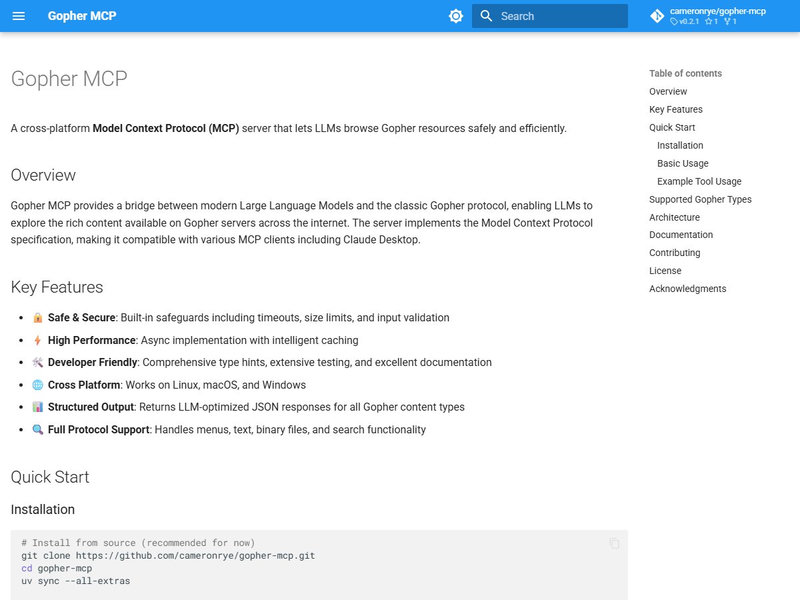
Gopher MCP Server
A modern Model Context Protocol server for Gopher and Gemini protocols, enabling AI assistants to browse these classic internet protocols safely and efficiently.
The integration of legacy protocols with modern AI infrastructure reveals fundamental insights about system design philosophy and the evolution of network architectures. The gopher-mcp implementation demonstrates how protocols designed with minimalist principles can provide superior performance characteristics and operational simplicity compared to their contemporary counterparts—lessons that remain highly relevant for modern distributed systems engineering.
Historical Context and Protocol Evolution
The Gopher protocol emerged during a critical period in network protocol development, representing an alternative architectural approach to information distribution that prioritized hierarchical organization over hypertext flexibility. Developed at the University of Minnesota under Mark McCahill’s leadership, Gopher implemented a client-server model that emphasized structured navigation and efficient resource discovery.
During the early 1990s, Gopher achieved significant adoption across academic and research institutions, often surpassing early web implementations in both performance and usability metrics. The protocol’s design philosophy centered on deterministic navigation patterns and minimal protocol overhead—characteristics that proved advantageous for the bandwidth-constrained networks of that era.
Protocol Competition and Market Dynamics
Gopher’s displacement by HTTP/HTML resulted from factors largely orthogonal to technical merit—a pattern frequently observed in technology adoption cycles. The critical factors included:
- Licensing Uncertainty: The University of Minnesota’s ambiguous intellectual property stance created adoption friction among commercial developers
- Media Type Limitations: Gopher’s text-centric design philosophy conflicted with the emerging multimedia requirements of commercial internet applications
- Architectural Philosophy: HTTP’s stateless, document-oriented model provided greater flexibility for dynamic content generation compared to Gopher’s hierarchical structure
The contemporary relevance of Gopher’s design principles becomes apparent when analyzing modern web performance challenges: content bloat, client-side complexity, and attention fragmentation. Gopher’s minimalist approach anticipated many of the performance optimization strategies now considered best practices in modern web development.
Contemporary Gopher Protocol Revival
The recent resurgence of Gopher protocol implementations reflects a broader movement toward minimalist computing and information consumption patterns. This revival demonstrates recognition of several architectural advantages:
- Content-Centric Design: Eliminates the presentation layer complexity that characterizes modern web applications, focusing exclusively on information delivery
- Minimal Protocol Overhead: Achieves near-optimal network utilization through elimination of unnecessary protocol features and metadata
- Implementation Simplicity: The protocol specification’s brevity enables rapid client development and reduces attack surface area
- Cognitive Load Reduction: Structured navigation patterns reduce decision fatigue and improve information consumption efficiency
The Model Context Protocol integration opportunity emerges from these characteristics: AI assistants require access to high-quality, structured information without the noise and complexity that characterizes contemporary web content. Gopher’s design philosophy aligns perfectly with AI information consumption patterns.
Model Context Protocol Integration Architecture
The Model Context Protocol establishes a formal abstraction layer between AI models and external resource systems, implementing capability-based security models that ensure safe resource access without compromising system integrity. This architectural approach addresses the fundamental challenge of enabling AI systems to interact with diverse external resources while maintaining security boundaries and operational predictability.
MCP’s design philosophy emphasizes explicit permission models and resource isolation—principles that align naturally with Gopher’s minimalist approach to information access. The protocol combination enables AI assistants to access curated, high-quality information sources without the security and complexity overhead associated with modern web browsing.
Building the Gopher MCP Server
Protocol Abstraction Layer
The architectural insight driving gopher-mcp development centers on protocol abstraction patterns that enable unified handling of related protocol families. Gopher and Gemini protocols share fundamental interaction models despite implementation differences, suggesting opportunities for abstraction that reduce code duplication while maintaining protocol-specific optimizations:
pub trait ProtocolHandler {
async fn fetch(&self, url: &str) -> Result<ProtocolResponse, Error>;
fn supports_url(&self, url: &str) -> bool;
}
pub struct GopherHandler;
pub struct GeminiHandler;
impl ProtocolHandler for GopherHandler {
async fn fetch(&self, url: &str) -> Result<ProtocolResponse, Error> {
let gopher_url = GopherUrl::parse(url)?;
self.fetch_gopher(&gopher_url).await
}
fn supports_url(&self, url: &str) -> bool {
url.starts_with("gopher://")
}
}
This abstraction demonstrates the Strategy pattern’s effectiveness in protocol handling scenarios. Protocol addition becomes a matter of trait implementation rather than core system modification, ensuring system stability while enabling rapid capability expansion—a critical requirement for production systems that must evolve without service interruption.
Gopher Protocol Implementation
The Gopher protocol is refreshingly simple. Here’s how a basic client works:
use tokio::net::TcpStream;
use tokio::io::{AsyncReadExt, AsyncWriteExt};
pub struct GopherClient;
impl GopherClient {
pub async fn fetch(&self, url: &GopherUrl) -> Result<GopherResponse, Error> {
let mut stream = TcpStream::connect((url.host.as_str(), url.port)).await?;
// Send Gopher request (just the selector + CRLF)
let request = format!("{}\r\n", url.selector);
stream.write_all(request.as_bytes()).await?;
// Read response
let mut buffer = Vec::new();
stream.read_to_end(&mut buffer).await?;
Ok(GopherResponse::parse(buffer, url.item_type)?)
}
}
This exemplifies the protocol’s minimalist design philosophy: request-response semantics without the complexity overhead that characterizes modern web protocols. The absence of status codes, headers, and content negotiation reduces both implementation complexity and network overhead—characteristics that prove advantageous for high-performance, low-latency applications.
Content Type Detection
Gopher uses a simple but effective type system that predates MIME types:
#[derive(Debug, Clone, Copy)]
pub enum GopherItemType {
TextFile = b'0',
Directory = b'1',
PhoneBook = b'2',
Error = b'3',
BinHexFile = b'4',
BinaryFile = b'9',
Mirror = b'+',
GifFile = b'g',
ImageFile = b'I',
// ... more types
}
impl GopherItemType {
pub fn to_mime_type(self) -> &'static str {
match self {
Self::TextFile => "text/plain",
Self::Directory => "text/gopher-menu",
Self::BinaryFile => "application/octet-stream",
Self::GifFile => "image/gif",
Self::ImageFile => "image/jpeg",
// ... more mappings
}
}
}
Practical Applications
Research and Documentation
One of the most compelling use cases I’ve discovered is research. Gopher servers often host high-quality, curated content:
- Academic papers: Many universities maintain Gopher archives
- Technical documentation: Clean, distraction-free technical docs
- Historical archives: Digital libraries and historical collections
When your AI assistant can browse these resources, it’s accessing information that’s often more reliable and better curated than random web pages.
Development Workflows
Here’s a practical example of how I use the Gopher MCP server in my development workflow:
# AI assistant browsing Gopher for technical documentation
> Browse gopher://gopher.floodgap.com/1/world for information about protocol specifications
# AI assistant accessing university research archives
> Search gopher://gopher.umn.edu/ for papers on distributed systems
# AI assistant exploring historical computing resources
> Navigate to gopher://sdf.org/1/users/cat/gopher-history for protocol history
The AI gets clean, focused content without the noise of modern web advertising and tracking.
Architecture Patterns for Protocol Servers
Resource-Centric Design
Building a protocol MCP server taught me the importance of separating concerns:
#[derive(Debug, Clone)]
pub struct Resource {
pub uri: String,
pub name: String,
pub description: Option<String>,
pub mime_type: Option<String>,
}
pub trait ResourceProvider {
async fn list_resources(&self) -> Result<Vec<Resource>, Error>;
async fn read_resource(&self, uri: &str) -> Result<Vec<u8>, Error>;
}
This pattern lets you swap out protocol implementations without touching the MCP logic. Want to add support for Finger protocol? Just implement the trait.
Async-First Architecture
Protocol servers need to handle multiple concurrent requests efficiently:
use tokio::sync::RwLock;
use std::collections::HashMap;
pub struct CachedProtocolHandler {
cache: RwLock<HashMap<String, CachedResponse>>,
handler: Box<dyn ProtocolHandler + Send + Sync>,
}
impl CachedProtocolHandler {
pub async fn fetch(&self, url: &str) -> Result<ProtocolResponse, Error> {
// Check cache first
{
let cache = self.cache.read().await;
if let Some(cached) = cache.get(url) {
if !cached.is_expired() {
return Ok(cached.response.clone());
}
}
}
// Fetch and cache
let response = self.handler.fetch(url).await?;
let mut cache = self.cache.write().await;
cache.insert(url.to_string(), CachedResponse::new(response.clone()));
Ok(response)
}
}
Best Practices for Protocol MCP Servers
Error Handling
Implement comprehensive error handling with context:
use thiserror::Error;
#[derive(Error, Debug)]
pub enum GopherError {
#[error("Network error: {0}")]
Network(#[from] std::io::Error),
#[error("Invalid Gopher URL: {url}")]
InvalidUrl { url: String },
#[error("Server error: {message}")]
ServerError { message: String },
#[error("Timeout connecting to {host}:{port}")]
Timeout { host: String, port: u16 },
}
Configuration Management
Keep configuration simple but flexible:
use serde::{Deserialize, Serialize};
#[derive(Debug, Deserialize, Serialize)]
pub struct GopherConfig {
pub default_port: u16,
pub timeout_seconds: u64,
pub max_response_size: usize,
pub cache_ttl_seconds: u64,
}
impl Default for GopherConfig {
fn default() -> Self {
Self {
default_port: 70,
timeout_seconds: 30,
max_response_size: 1024 * 1024, // 1MB
cache_ttl_seconds: 300, // 5 minutes
}
}
}
The Future of Alternative Protocols in AI
Building the Gopher MCP server opened my eyes to something interesting: there’s a whole ecosystem of alternative protocols that could benefit AI assistants:
- Gemini: Gopher’s modern successor with TLS and markdown support
- Finger: Simple user information protocol
- NNTP: Network News Transfer Protocol for accessing Usenet
- IRC: Real-time chat protocol integration
Each of these protocols represents a different approach to information sharing, and each could provide unique value to AI assistants.
Architectural Insights and Design Principles
The gopher-mcp implementation reveals fundamental insights about the relationship between protocol complexity and system reliability. Gopher’s design philosophy—prioritizing content delivery over presentation flexibility—aligns naturally with AI information consumption patterns, where structured data access takes precedence over multimedia presentation.
The protocol’s architectural simplicity provides an ideal foundation for understanding MCP server design patterns. The minimal complexity overhead enables focus on core architectural concerns—resource management, caching strategies, and error handling—without the distraction of protocol-specific edge cases that characterize more complex implementations.
Getting Started
Want to try the Gopher MCP server yourself? Here’s how to get started:
# Install the server
cargo install gopher-mcp
# Configure your AI assistant to use it
# (specific steps depend on your MCP client)
# Start exploring Gopher space
# Try gopher://gopher.floodgap.com/ for a good starting point
The Gopher internet is small but surprisingly rich. You’ll find everything from technical documentation to poetry, all presented in that clean, distraction-free format that makes information consumption a pleasure rather than a chore.
Interested in exploring more? Check out the gopher-mcp repository for complete implementation details and examples.
